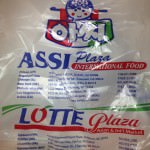While I post mostly about the sights and experiences along the Lincoln Highway, I want to talk about something that unifies all of us humans, and that’s food. Food defines us as a culture and some of our best memories come through the food we’ve made and eaten over time. For those of us who have food sensitivities, journeys like the one that I’m on can be intimidating. Since 2002, I’ve lived a gluten and dairy free lifestyle for medical reasons (there are more sensitivities than this, but these are the big 2 for me). 11 years in the gluten/dairy free world, and so much has changed. I never thought I’d be able to eat pizza in public again, but there are restaurants that make gluten free pizza with non-dairy cheese! Awareness has grown so much just even in the last couple years, rural America knows more about food allergies than ever before.
I’m currently in Iowa, about halfway time-wise on my tour (three months so far, and three to go), so I feel like I can speak about the pluses and pitfalls about living on the road with multiple food allergies. I’ll be honest, I’ve been sick a few times from food I thought was safe that really wasn’t safe (those places will not be mentioned in this post), BUT there’s a lot of great “mom-and-pop” places along the route that are way more accommodating to food-savvy folks like us than typical chain restaurants. As people are becoming more aware about what’s in their food, local diners (especially in the heartland) will source more and more ingredients from people they know. The retro diner that looks like it will have nothing to eat might actually have something that’s okay for you. The owner or owner’s daughter might have Celiac disease, and whoa, the whole kitchen is dedicated gluten free.
There’s tons of people and bloggers who have written about how to travel safe while on a restricted diet, and there’s a lot of great tips out there. I won’t be overly repetitive about what they’ve said, but I will tell you a few things that have worked for me.
1) Bring your own food
In a future post you’ll see how I packed for a 6 month trip (it’s not as easy as it looks), but I can tell you I packed and re-packed my “safe food” stash to have with me when I wouldn’t have access to food. Having food that’s shelf-stable is key for a six-month journey, and then supplementing with local produce/deli is crucial.
A huge plus with a growth in gluten free awareness is that I’ve been able to find and buy loaves of GF bread from reputable companies in grocery stores that were in the middle of nowhere. Amish and Mennonite areas even have gluten free sections now in their stores, as people in their populations have Celiac disease as well. Brands like The Gluten Free Bar, Schar, and Kinnikinnick make shelf stable products (many with non-GMO ingredients), and GFree Connect provides care packs that have sample sizes which are perfect for travel.
2) Bring extra supplements
Those of you who have a specialized diet probably have a supplement routine to keep yourself healthy, including vitamins and digestive enzymes. I am NOT a medical or health professional, so this section can and should be tailored to what’s best for you. If you eat something that makes you sick, remember your body needs an extra “nudge” to get better, especially while dealing with the stress of traveling. When I did get sick from food, the key was hydration, rest, and taking extra supplements. I am happy to report that after three months on the road, I’ve been food sick only and not other types of sick (knocks on wood). I realize getting sick from food is not great, but I feel the need to celebrate small victories where I can. My supplements have helped me cope with the changes in climate, time zones, and weird schedules without getting even a single head cold. Either way, follow the advice of your health care practitioner no matter what I’ve written here, and if your symptoms are severe while on the road seek medical attention immediately.
3) Do Your Homework Before, During and After Your Trip
Anyone who lives this way knows your work is never done in regards to keeping optimum health. You’re always reading labels, looking at menus online, and calling restaurants in advance of your arrival to make sure everything is safe. If you have a smartphone, use those apps that will help you find what you need. For me, Find Me Gluten Free and Yelp have been a godsend and extremely crucial for my trip so far. I’ve been able to locate and read reviews of restaurants and grocery stores (again I like to give my money to local communities, not chains if possible) and use them to my benefit. When in doubt, don’t eat there!
4) Consider Alternative Housing Arrangements While on the Road
This tour has been a grassroots tour from the get-go, and that means I’ve relied on the kindness of strangers to give me a couch/bed to sleep on. One of those components of finding people to stay with is through CouchSurfing. With CouchSurfing, you can create a profile and note your food allergies. You can either be a host to people, or people can host you. Depending on where you are going, you can find people who can accommodate your lodging and dietary needs (i.e. cross-contamination free kitchens) plus get a local’s perspective of the community you are traveling through. Air Bnb also has affordable accommodations as well that might have kitchens where you can cook your own food as well.
Below is a few snapshots of some of my positive food experiences. I couldn’t put the web links to the restaurants in the pictures, so click below on the name of the place if you want to learn more about them.
*I was not compensated by any places or companies above to endorse their product(s). Please read all labels and menus before consuming any food to make sure it’s right for you.











